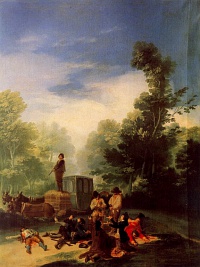Highwayman
From The Art and Popular Culture Encyclopedia
|
"In true highwayman voice, he called out, "Stand and deliver!"--English Eccentrics and Eccentricities (1866) by John Timbs |

|
Related e |
|
Featured: |
Highwayman was a term used particularly in Britain during the 17th and 18th centuries to describe robbers who targeted people traveling by stagecoach and other modes of transport along public highways. They would use or threaten violence in order to seize money and other valuables from their victims. A highwayman rode a horse, and usually carried a pistol. He might announce himself with the phrase "Your money, or your life!", or "Stand and deliver!", although these phrases owe more to literary tradition than reality.
Well-known highwayman's haunts included several places around London: Blackheath and nearby Shooter's Hill, Hounslow Heath, and Wimbledon and Barnes Commons.
Literature and popular culture
In Shakespeare's Henry IV, Part 1 Falstaff is a highwayman, and part of the action of the play concerns a robbery committed by him and his companions. Apart from Falstaff, the most famous highwayman in English drama is Captain Macheath, hero of John Gay's 18th-century ballad opera The Beggar's Opera. The legend of Dick Turpin owes an enormous amount to Rookwood (1834), in which a heavily fictionalised Turpin is one of the main characters. Alfred Noyes's narrative poem "The Highwayman" has been immensely popular ever since its publication in 1906.
There were many broadsheet ballads about highwaymen; these were often written to be sold on the occasion of a famous robber's execution. A number of highwaymen ballads have remained current in oral tradition in England and Ireland.
From the early 18th century collections of short lives of highwaymen and other notorious criminals became very popular. The earliest of these is Captain Alexander Smith's Complete History of the Lives and Robberies of the Most Notorious Highwaymen (1714). Some later collections of this type had the words The Newgate Calendar in their titles and this has become a general name for this kind of publication.
In the later 19th century highwaymen such as Dick Turpin were the heroes of a number of "penny dreadfuls", stories for boys published in serial form. In the 20th century the handsome highwayman became a stock character in historical love romances, including books by Baroness Orczy and Georgette Heyer.
The Carry On films included a highwayman spoof in Carry On Dick (1974). Monty Python sent up the highwayman legends in the Dennis Moore sketch in Episode 37 of Monty Python's Flying Circus, in which John Cleese played the titular criminal who stole only lupins. In Blackadder the Third, Mr. E. Blackadder turns highwayman in the episode "Amy and Amiability." In the British children's television series Dick Turpin, starring Richard O'Sullivan, the highwayman was depicted as an 18th-century Robin Hood figure.
The traditional Irish song "Whiskey in the Jar" tells the story of an Irish highwayman who robs an army captain, and includes the lines "I first produced me pistol, then I drew me rapier. Said 'Stand and deliver, for you are a bold deceiver.Template:'"
The traditional Irish song "The Newry Highwayman" recounts the deeds and death of a highwayman who robbed "the lords and ladies bright."
Adam and the Ants had a number one song for five weeks in 1981 in the UK with "Stand and Deliver." The video featured Adam Ant as an English highwayman.
The highwayman known as Juraj Jánošík (1688–1713) became a hero of many folk legends in the Slovak, Czech, and Polish cultures by the 19th century that hundreds of literary works about him have since been published. The first Slovak feature film was Jánošík, made in 1921, followed by seven more Slovak and Polish films about him.
Films
- In the Grip of Death (1913)
- A Woman of the World (1916)
- Bladys of the Stewpony (1919)
- The Call of the Road (1920)
- The Shadow of Lightning Ridge (1920)
- Lorna Doone (1922)
- Claude Duval (1924)
- Diego Corrientes (1924)
- Dick Turpin (1925)
- El Caballero de la noche (1932)
- The Wicked Lady (1945)
- The Loves of Carmen (1948)
- The Highwayman (1951)
- The Lady and the Bandit (1951)
- The Highwayman (1958) (TV)
- Castello dei morti vivi, Il (1964)
- The Amorous Adventures of Moll Flanders (1965)
- Wang ming tu (1972)
- Carry On Dick (1974)
- Barry Lyndon (1975) – Captain Feeney
- Joseph Andrews (1977)
- The Wicked Lady (1983)
- The Lady and the Highwayman (1989)
- Plunkett & Macleane (1999)
- Highwaymen (2003)
See also

